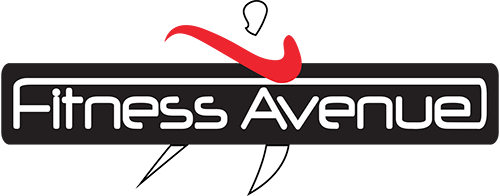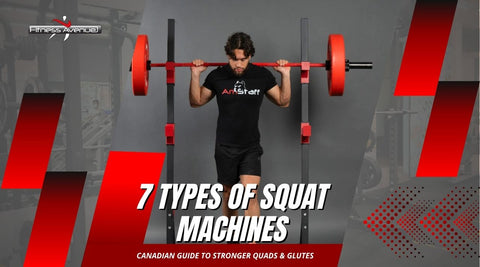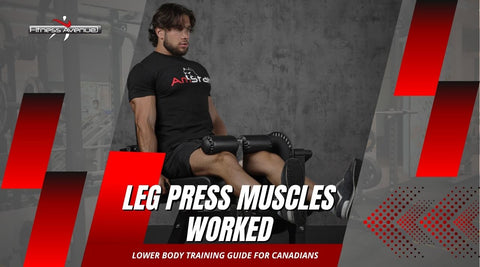Building powerful quads and glutes requires the right equipment, and understanding the different types of squat machines available can transform your lower body training.
Whether you're dealing with back pain, seeking to isolate specific muscles, or want safer alternatives to barbell squats, modern squat machines offer targeted solutions for every fitness goal.
From sissy squat machines that deliver intense quadriceps isolation to belt squat systems that eliminate spinal stress, today's equipment bridges the gap between safety and effectiveness.
Research has shown that specialized squat machines can reduce lower back stress while maintaining similar muscle activation to traditional barbell squats. Therefore, selecting the right squat machine is crucial for achieving long-term training success.
Quick Summary
- Belt squat machines eliminate spinal loading while maintaining excellent quad, hamstring, and glute activation—ideal for those with back issues
- Hack squat machines provide guided movement patterns perfect for heavy loading and quadriceps isolation with enhanced safety features
- Sissy squat machines deliver unparalleled quadriceps targeting through unique biomechanics that can't be replicated with other exercises
- Pendulum squat machines offer a deeper range of motion and comprehensive muscle activation through natural swinging mechanics
- V-squat machines reduce joint stress while providing functional movement patterns that bridge machine and free weight training
- Machine-based training allows for higher training volumes and safer progression compared to free-weight squats
Top 7 Squat Machine Types You Should Know
1. Sissy Squat Machine

Description and How It Works: The sissy squat machine facilitates one of the most unique quadriceps exercises in strength training. Unlike traditional squat movements that involve hip and knee movement, the sissy squat isolates the quadriceps by maintaining hip extension while the user leans backward with their knees bent. The machine provides essential stability through padded shin supports and adjustable footrests, enabling users to perform this challenging movement safely while targeting specific leg muscles with proper form.
Our AmStaff Fitness Sissy Squat features adjustable design elements, comfortable high-density foam padding, and a compact footprint, making it perfect for home gyms. With a 440 lb weight capacity and sturdy steel construction, it delivers professional-grade performance in a space-efficient design.
Pros and Cons: The primary advantage lies in unmatched quadriceps isolation, particularly targeting the vastus medialis oblique (VMO) muscle, which is crucial for knee stability. This design combines safer, guided movement with a compact form that fits seamlessly into smaller training environments.
However, the exercise requires proper progression and mastery of technique, making it less suitable for complete beginners. The intense quadriceps stress can be overwhelming initially, requiring gradual adaptation.
Best For: Sissy squats excel for bodybuilders seeking quad definition, athletes requiring VMO strengthening for knee stability, and anyone with hip or glute injuries who needs to maintain quadriceps strength. They're also valuable for individuals who find traditional squats uncomfortable due to back issues.
2. Belt Squat Machine
Description and How It Works: The belt squat machine revolutionizes squatting by transferring load from the spine to the hips through a specialized belt system. This innovative approach eliminates axial loading of the vertebral column while maintaining effective lower body training. The user wears a weighted belt connected to the machine's loading system, allowing a natural squatting motion without spinal compression. The belt squat muscles worked include the quadriceps, glutes, and hamstrings, while the upper body remains completely unloaded.
Our AmStaff Fitness Standing Belt Squat represents the pinnacle of belt squat technology, offering professional-grade construction with user-friendly features that make this advanced training method accessible to everyone.
Pros and Cons: The standout benefit is complete spinal decompression—research shows a reduction in lower back muscle activation compared to traditional squats. This makes the belt squat ideal for individuals with back injuries or those prioritizing long-term spinal health. The system enables high-volume training without cumulative spinal stress and often allows heavier loading than back squats. The downside includes higher equipment costs and potential availability limitations in many gyms.
Best For: Belt squats are perfect for athletes recovering from back injuries, older adults seeking safer strength training, and competitive athletes managing training volume during intense periods. They're also excellent for those who want to train legs frequently without the recovery demands of spinal loading.
3. Hack Squat Machine

Description and How It Works: The hack squat machine features an angled platform (typically 45 degrees) with shoulder pads and a guided rail system. Users position themselves on the platform with their back against the pad and shoulders under the supports, then perform squats along the predetermined path.
The machine's design keeps the torso stable while focusing all effort on the lower body muscles. The muscles primarily worked by the hack squat include the quadriceps, with secondary emphasis on the glutes and hamstrings, depending on foot placement.
Our featured AmStaff Fitness Standing Hack Squat combines durability with versatility, offering a reversible design, functionality and adjustable foot placement options. Built with heavy-duty steel construction and a maximum load capacity of 770 lbs, it provides professional-grade performance for serious lifters.
Pros and Cons: The hack squat excels at isolating the quadriceps while providing superior safety through guided movement patterns. The machine eliminates balance requirements, allowing users to focus solely on force production and often handle heavier loads than free-weight squats. Multiple foot positioning options allow for targeted muscle emphasis across various muscle groups. However, the fixed path may not accommodate all body types, and some users initially find the starting position uncomfortable.
Best For: Ideal for bodybuilders seeking maximum quadriceps development, beginners learning squatting movements safely, and anyone wanting to train with heavy loads without requiring spotters. They're also valuable for high-volume training without excessive stabilization fatigue.
Also read: Hack Squat vs Squat
4. Front Squat Machine
Description and How It Works: The front squat machine maintains the anterior loading position of barbell front squats while providing additional stability and safety features. These machines position the weight in front of the body, emphasizing an upright torso position throughout the movement. Some versions utilize Smith machine setups with a barbell fixed to vertical rails, while specialized machines offer dedicated front squat functionality that targets lower-body muscles with enhanced quadriceps activation.
Pros and Cons: Front squat machines provide superior quadriceps activation compared to back-loaded variations while reducing spinal compression. They promote better posture and require significant core stability, thereby contributing to the development of functional strength. The anterior loading position is easier to abandon safely during failed repetitions. However, these machines often require specific mobility in the shoulders and ankles, and may not be available in all facilities.
Best For: Excellent for individuals prioritizing quadriceps development while protecting spinal health, athletes requiring functional strength patterns, and those with lower back concerns who still want challenging leg training. They're also valuable for developing better squatting mechanics and posture while maintaining proper alignment.
5. Lever Squat Machine
Description and How It Works: The lever squat machine utilizes a pivoting mechanism that creates a natural arc of movement during the squat. This design philosophy differs from linear machines in that it accommodates the body's natural movement patterns through a curved motion profile. The leverage squat machine often provides variable resistance that changes throughout the range of motion, allowing users to adjust their foot positioning to target different muscle groups.
Pros and Cons: The curved movement pattern feels more natural than linear machines and often allows for deeper squat depth. Lever systems typically provide smoother resistance curves and may reduce joint stress through their biomechanically optimized paths. The trade-off includes potentially higher costs and more complex mechanical systems that may require additional maintenance.
Best For: Suitable for users seeking more natural squat mechanics than traditional machines provide, those with mobility limitations that benefit from accommodating resistance, and facilities prioritizing biomechanically advanced equipment for diverse populations.
6. Squat Calf Machine
Description and How It Works: Squat calf machines combine a squatting movement with calf raise functionality, allowing users to target both large muscle groups in a single exercise. These machines typically feature adjustable shoulder pads and platforms that enable a full range of motion for squats, followed by calf raises at the top position, providing a comprehensive lower-body workout.
Pros and Cons: These machines provide time-efficient training by combining two exercises, making them valuable for shorter workouts or circuit training. They ensure consistent calf training that might otherwise be neglected. However, combining movements may compromise the effectiveness of each component compared to dedicated exercises.
Best For: Ideal for time-pressed individuals who want comprehensive lower body training, beginners learning to coordinate multiple muscle groups, and facilities with space limitations requiring multi-functional equipment.
7. V-Squat Machine
Description and How It Works: The V-squat machine features a distinctive V-shaped frame geometry that creates a more natural foot and hip angle compared to linear squat machines. This design reduces shear stress on the knees and hips while providing a guided movement pattern that accommodates individual anatomical variations more effectively than rigid hack squat designs. The V squat allows for natural squat mechanics while maintaining the safety benefits of guided movement.
Pros and Cons: The V-angle provides more natural movement patterns and reduces joint stress while maintaining effective muscle activation. These machines often allow for various stance widths and foot placement options, providing versatility in muscle targeting. The design may be more expensive than simpler alternatives and requires adequate floor space.
Best For: Excellent for individuals with joint concerns who need lower-impact training, athletes seeking functional strength development, and facilities prioritizing joint-friendly equipment for diverse user populations.
How to Choose the Right Squat Machine for Your Fitness Goals

Selecting the optimal squat machine type depends on your primary training objectives, physical limitations, and available space. For muscle building, hack squat and pendulum squat machines offer superior isolation and loading capabilities. Those prioritizing joint health should consider V-squat machines or belt squat machines that reduce stress while maintaining effectiveness.
Beginners benefit most from hack squat machines due to their stability and safety features, while advanced lifters may prefer belt squats for volume training or sissy squats for specialized development. Consider your available space—compact sissy squat machines are ideal for smaller areas, while hack squats require a significant amount of floor space.
Budget also influences decisions, with basic machines starting affordably, while advanced systems, such as pendulum squat machines, command premium prices. Evaluate your gym's existing equipment to avoid redundancy and complement your current lower-body training setup.
What Are the Benefits of a Squat Machine?
Squat machines offer several compelling advantages over free-weight alternatives. Enhanced safety tops the list—guided movement patterns eliminate balance failures and provide built-in safety stops, allowing training to failure without the need for spotters.
Targeted muscle activation enables precise emphasis on specific muscle groups by adjusting foot placement and machine angle. Research shows machines can achieve similar muscle activation to free weights while using lower absolute loads, indicating superior training efficiency.
Reduced injury risk comes from eliminating technique breakdown under fatigue and providing consistent movement patterns. The learning curve is dramatically shorter, enabling beginners to perform squats immediately rather than spending months mastering proper squat form.
Volume tolerance increases significantly since machines reduce systemic fatigue from stabilization demands, allowing more frequent training and higher repetition protocols. This proves particularly valuable for hypertrophy-focused programs requiring consistent high-volume stimulus.
How to Include Squat Machines in Your Leg Routine?

Effective integration depends on your training philosophy and existing program structure. Primary movements are well-suited for beginners or those with physical limitations—start with 3-4 sets of 8-12 repetitions using hack squat or V-squat machines as your primary leg training exercise.
Accessory applications are suitable for more advanced trainees who use free-weight squats as foundational movements. Add sissy squats for quadriceps finishing work or belt squats for high-volume training without spinal stress. Position these after compound movements when technique is still solid, but intensity can be maintained at a high level.
Specialization phases benefit from machine focus—dedicate 4-6 weeks to specific machine emphasis for addressing weak points or working around injuries. Browse our Fitness Avenue homepage to discover comprehensive equipment solutions that support every phase of your training journey.
Progressive overload remains crucial—gradually increase weight plates, repetitions, or range of motion. Machines make progression tracking simpler through precise load adjustments and consistent movement patterns across squat variations.
FAQs
Are the V-squat and the pendulum squat the same?
No, these are distinctly different squat machines. V-squat machines utilize a fixed V-shaped frame geometry with linear movement, whereas pendulum squats employ a swinging arc mechanism that generates curved motion patterns. Pendulum squats typically allow for a deeper range of motion and more natural movement trajectories compared to the more rigid paths of v-squat machines.
Are squat machines good?
Yes, research demonstrates that squat machines provide similar muscle activation to free-weight squats, while often allowing higher loads and training volumes. They're particularly effective for isolated muscle development, injury prevention, and enabling consistent training for individuals with technical or mobility limitations. Different squat machines excel at targeting various lower-body exercises.
Which squat machine is best for beginners?
Hack squat machines offer the best starting point for beginners due to their stability, safety features, and intuitive movement patterns. The guided motion eliminates balance challenges while teaching proper squatting mechanics. V squat machines provide another beginner-friendly option with joint-friendly characteristics.
Are squat machines suitable for people with knee pain?
Many squat machines can accommodate knee issues better than free weights. Belt squats eliminate spinal loading while allowing for leg workouts. V-squat machines reduce joint shear stress, and proper foot placement on hack squats can minimize knee stress. However, individuals with knee pain should consult healthcare providers before beginning any squatting program.
Do squat machines provide similar benefits to barbell squats?
Squat machines excel at isolating muscles and increasing volume, but may not provide the same stabilization and coordination benefits as free-weight squats. They're complementary rather than replacement tools—machines provide safety and targeted development while free weights offer functional strength and movement skills.
Build Stronger Quads and Glutes With the Right Machine
The variety of different squat machines available today ensures there's an optimal solution for every training goal, physical limitation, and experience level. Whether you need the spinal-friendly benefits of belt squats, the targeted isolation of sissy squats, or the beginner-friendly nature of hack squats, modern machines deliver results safely and effectively.
Success comes from matching machine characteristics to your specific needs rather than assuming one squat machine type suits all purposes. Beginners benefit from the stability and safety of hack squats, while advanced lifters might leverage belt squats for volume or sissy squats for specialization work. Those with joint concerns find relief in V-squat designs, while space-conscious home gym owners appreciate compact sissy squat options.
Ready to upgrade your leg training? Explore our complete selection of professional-grade squat machines and start building the powerful, defined lower body you've been working toward. With fast shipping across Canada and the US, plus our expert guidance, your perfect squat machine solution is just a click away.
Citations:
[1] https://pmc.ncbi.nlm.nih.gov/articles/PMC7126258/
[2] https://pmc.ncbi.nlm.nih.gov/articles/PMC10987311/



